Adopting a new kitten is a time that is full of excitement and joy, but if you’ve never owned a cat before, you might be as nervous as a first-time mother. There are many different things you’ll need to learn about cats and supplies you’ll need on hand to have everything ready for your new kitten to come home.

So how do you take care of a kitten from eight weeks of age to a year? Taking care of a new kitten includes the following:
- Getting it used to you and your home
- Making sure it is socialized and trained to the litterbox
- Providing proper nutrition
- Providing essential veterinary care such as vaccinations
- Providing toys, grooming supplies, and other accessories
Before you get a kitten, the smartest thing to do is read up on cats and learn how to take care of one. If you make the right preparations, you’ll end up with a beautiful, happy, friendly cat that is adored by everyone in the household.
Read on to find out more about what you need to bring a new kitten into your home and raise it through the first year.
Table of Contents
Supplies Needed for a New Kitten
Before you go out and pick up a kitten, you need to have everything for the kitten on hand at the house already to make sure that you don’t forget something important.
It just adds extra stress to acquire a kitten only to realize that you don’t even have a litterbox set up yet, meaning you have to postpone acclimating your kitten to a quiet home for a stressful shopping run instead.
It’s not a good way to get off on the right foot with your new friend, especially during a time when they’ve been separated from their mother and they’re usually feeling very vulnerable and afraid.
Here are some of the things you need to already have installed in your household before you go to pick your new kitten up:
- Food and water bowls: Kittens need a kitten-sized food and water bowl, and the best kind to get them are weighted bowls (I like these ones ).
These bowls will prevent the kitten from accidentally spilling food and water everywhere as it tries to feed itself since they can be quite clumsy when they’re very small and it takes them a while to get used to eating from a bowl.
- Cat bed: Providing a cat bed gives your kitten a place where it can rest—beds are usually built either in a circular design or a covered design to encourage cats to use them.
Cat beds come in a dazzling array of colors and materials. It’s important to choose a smaller bed suited to your kitten’s size to make it more comfortable. You can buy your kitten a larger bed as it grows.
- Litterbox: A litterbox is one of the most important things to have to raise a new kitten, and litterboxes come in a variety of designs and shapes. One popular option is the self-cleaning litterbox , which can cut down on the amount of time you spend cleaning the litterbox and how dirty it gets overall.
- Litter: A litterbox is useless without litter . There are many kinds of litter designed for everything from odor control to multiple cat households, so you may have to try a few kinds to find the type you like best. It’s always best to keep a backup container of litter on hand in case you run out or need to top off the litterbox.
- Food and treats: Like the litterbox, you should have food and water ready for your kitten when you bring them home. To prevent stomach troubles, the best option is to get some of the food from the place you’re acquiring your kitten and mix it with your chosen cat food brand at first so that the kitten can become used to the change.
- Scratching post: Providing a scratching post right away and showing the kitten where it is can be crucial for preventing the kitten from getting into the habit of scratching on your furniture instead. All kittens will feel the strong urge to sharpen their claws, and if you don’t give them an appropriate place to do it, they’ll do it in a place you won’t like.
- ID tags: While you may or may not elect to put a collar on your cat for safety reasons, keeping your cat’s rabies tag on hand is important for documentation to animal control. If you choose not to put an ID tag and collar on your cat, an ID microchip is also another option that can help bring your kitten home if they get out of the house.
- Collar: Cats can get their collars easily hung on things because of the way they move, so if you choose to put a collar on your cat, you should choose a breakaway model that will snap if your kitten gets caught up on something in the home. This will prevent the animal from accidentally strangling. If your cat is going to go outside at all, a collar and ID are vital.
- Enzyme-based cleaning supplies: Though kittens don’t have as many housebreaking issues as puppies do, they sometimes do have accidents in the house when they are unfamiliar with their surroundings or have an upset stomach from deworming medication. To combat this, have an enzyme-based cleaner on hand so that you can thoroughly sterilize any accidents.
- Playpen: If you get a kitten that is very young, it’s usually best to keep it under close supervision at first. One way of doing this is by providing an enclosed playpen that the kitten can stay in when they aren’t being actively supervised. These soft-sided playpens are perfect for young kittens until they are old enough to have full run of the house.
- Cat carrier: Cat carriers are the easiest way to transport your new kitten without having to worry about them squirming out of your grip and running away on a trip to the vet or when moving the cat from one building to another. Make sure that you get a carrier that is large enough to accommodate a full-sized cat so you don’t have to upgrade later.
- Cat leash/harness: If you decide to take your cat outside, training them to a cat leash and harness is the safest way to do it. Cats that are allowed to roam free outdoors have a drastically reduced lifespan in comparison to cats that are kept inside, so if you decide to let your cat out, be sure to have them on a leash.
- Bitter apple spray: Bitter apple spray is a spray used in pet training to deter kittens from chewing on electrical wires and other household objects that could potentially harm them (or get damaged). This spray works by coating the object in a foul-tasting chemical that is distasteful to cats and dogs.
- Grooming supplies: Cats are good at grooming themselves, but it’s always a good idea to have a brush and nail clippers on hand when you get a new kitten. It is important to acclimate new kittens to the sensations of having their fur brushed and their claws clipped at a very young age to prevent them from being averse to it in adulthood.
Once you have all the supplies you need for your new kitten, the next thing you should do is focus on kitten-proofing your house. Kittens are notoriously mischievous and can get into some dangerous situations if left unattended.
Go through the house and check for anything that might accidentally hurt them. This includes hazards such as the following:
- Electrical wires (kittens love chewing on these)
- Drapery cords
- Poisons
- Fragile or breakable objects you don’t want the kitten knocking over
For a more in-depth guide on kitten-proofing your home, check out this guide at Vetstreet.
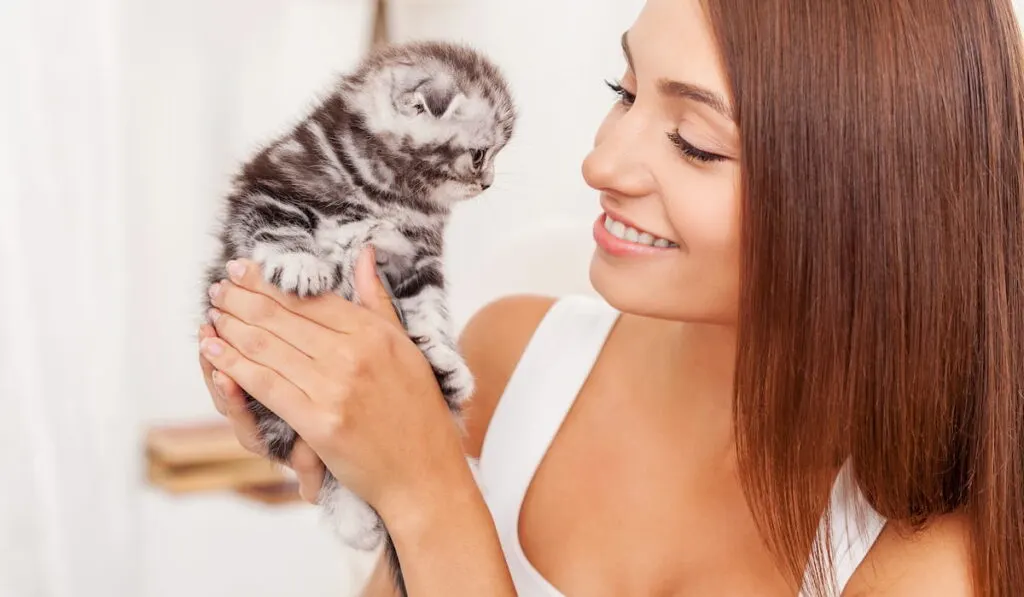
Acclimating a New Kitten
When you bring home a new kitten for the first time, it’s important to look at the situation from the kitten’s perspective. Up until this point in its life, it has only known its mother, its siblings, and maybe a few people from the household it came from.
It’s important when you handle the kitten that you make it feel safe and protected, holding it close to your body and petting it gently.
At first, a new kitten may try to run and find a secure hiding spot when you first let it loose in the house, so it’s a good idea to confine the kitten to a safe place at first (either a kitten-proofed room or an enclosed playpen) so that it can’t get trapped under or in something in its attempts to hide.
If your kitten hides when you first bring it home, it’s best to give it some personal space in a dim, quiet area so it can become calm and curious. Once the kitten is more comfortable and realizes that its new environment is safe, it will start coming out and exploring of its own accord.
If there are other animals in the household (such as dogs) it is important to keep the kitten separated from these other animals by a door that they can smell each other beneath for at least a few weeks to make sure that the older animals will accept the kitten.
A kitten can be quickly killed by an overly enthusiastic or predatory large dog, so be cautious to ensure that there aren’t any accidental injuries.
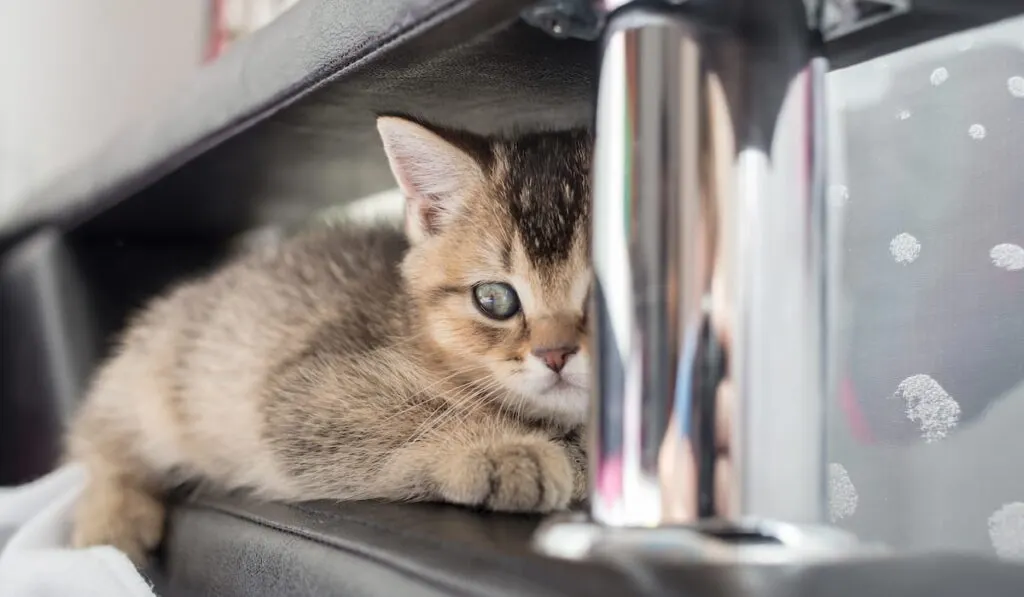
Socializing a New Kitten
You shouldn’t force your kitten to socialize with many people right away since this can make it frightened and combative.
Many people make the mistake of showing off their new kitten to all their friends and family within hours of bringing it home, which can leave the kitten an overstimulated mess by the end of the day.
Rather than chase a kitten in an attempt to pick it up (which can make your new kitten afraid of you) you should quietly sit in the floor where the kitten has easy access to you and either do something else like read a book or entice it to play with a toy or a piece of string.
Depending on how shy your kitten is, it may take a little while for the kitten to become comfortable with approaching you.
Once a kitten is more used to being handled, it is also important to gently touch all its feet (massaging the pads to unsheathe the kitten’s claws) and look at its teeth. These interactions can be gradually incorporated into more regular petting.
The reason for these mock examinations is that the more comfortable your kitten is with being touched all over, the easier time your veterinarian will have examining the kitten. It also makes clipping nails much easier.

Nutrition for Kittens
Kittens require a different level of nutrition than adult cats—they need more calories and nutrients than older cats. For this reason, kittens should be fed kitten food up until they are a year of age.
If cats are fed kitten food past this age, it won’t hurt them, but the extra calories may cause them to become overweight if they aren’t very active.
It is important for cats to be fed food that is formulated for cats since cats are what is known as an obligate carnivore—that is, they must have access to food that is meat-based.
Kitten food can come in both wet and dry forms, though many people tend to favor dry kitten food since it can be left out without spoiling and has less odor.

New Kittens and The Litterbox
One of the best things about bringing home a new kitten versus bringing home a puppy is that kittens are much easier to housebreak. For the most part, if a kitten is shown where its litterbox is, it will naturally gravitate towards that spot to use the restroom as long as it has constant access to it.
To encourage your kitten to use its litterbox, you should employ the following tips:
- When you bring your new kitten home, take the kitten to the litterbox and place it inside, taking its front paws and patting them gently on the surface of the litterbox with shallow scooping motions that emulate the way a cat will dig in its litterbox. This will demonstrate to the kitten that the litterbox is its restroom.
- If your kitten does have a housebreaking accident and uses the bathroom somewhere other than its litterbox, the spot should be cleaned with an enzyme cleaner to prevent the kitten from trying to use the same spot. Do not punish your kitten for having an accident in the house. The kitten will only learn to fear you, not use the litterbox.
- Make sure that the litterbox is cleaned daily and that it is constantly supplied with fresh litter. Most cats will only resort to using the bathroom outside of their litterbox when the litterbox is so soiled they aren’t comfortable in it. Cleaning the litterbox daily ensures that your cat will use it and keeps your cat from walking around in dirty litter before walking around in your house.
- It can be helpful to place a mat at the entrance of the litterbox to help catch any stray litter that is left on the kitten’s paws, as well as any litter that the kitten might accidentally kick out of the litterbox onto the floor. Otherwise, you might find yourself sweeping the area around the litterbox more often than you’d like.
Training Kittens
Kittens typically receive a lot less formal training than puppies when they are being introduced to your household, but there is still some training that they require to be good pets.
When you first bring your kitten home, its training is very simple things like learning to be handled comfortably and learning where its litterbox is. But as the kitten gets older, its behavior will become more mischievous.
It is crucial to remember that kittens and puppies are very much like newborn babies and learn about their environment through exploration.
You should never, ever hit or punish a kitten for doing something you don’t like. Unlike a dog, which may ultimately forgive you for striking it in anger, many cats will write you off and refuse to interact with you if you physically punish them. Physical discipline should never be used with either species, however.
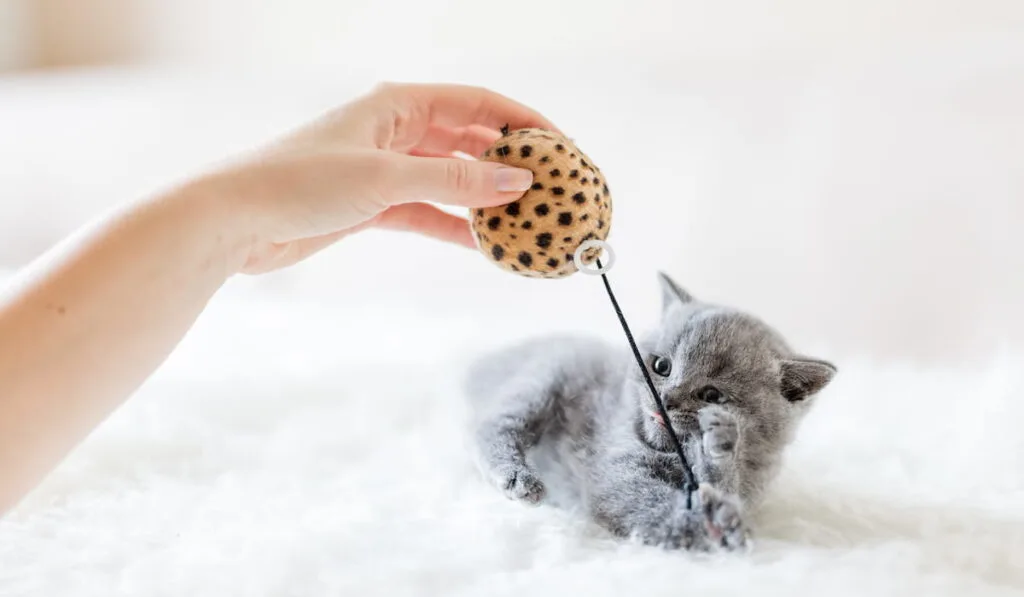
Here are a few things that you may need to address in training your new kitten:
- Scratching: New kittens will scratch anything they can get their claws on from curtains to carpets if they aren’t given an appropriate outlet for this natural behavior. To avoid having your fabrics shredded, it’s important to invest in a good scratching post. You should also deter your cats from scratching areas like the couch or curtains by stopping the kitten when you catch them trying to scratch those areas and gently replacing them at the scratching post instead.
- Biting and clawing: Kittens go through very intense periods of play fighting during their development with other kittens, so if a kitten is deprived of this development, they will seek an outlet through this behavior by doing it to people. Many people accidentally encourage this behavior in kittenhood only to find it is a major problem in adolescent cats, so roughhousing should be redirected at toys instead.
- Forbidden areas: Many people train their cats to stay off of tabletops and counters, both for sanitary reasons and because cats are prone to knocking things off of these surfaces and breaking them. To prevent kittens from getting on forbidden areas, spray these areas down with a No products found..
- Night-time mischief: Cats are naturally nocturnal, which means that when you’re ready to hit the sack, they’re often ready to go gallivanting across the house as loudly as possible. To avoid being disturbed by the kitten all night, sleep with your bedroom door closed or teach the kitten to be “put to bed” every evening in an enclosed room such as a laundry room where they have access to their food, water, toys, and litter.
- Climbing: Kittens are very attracted to climbing activities when they’re young since these activities help strengthen their limbs and teach them how to control their retractable claws. Providing climbing-friendly areas such as cat activity trees can help keep kittens from climbing things you don’t want them to climb, like your pants leg or your drapery.
There is more advanced training you can undertake with your kitten, such as tricks, but the fundamentals listed above will cover the most obvious behavioral problems you’re likely to encounter in your first year of raising a cat.
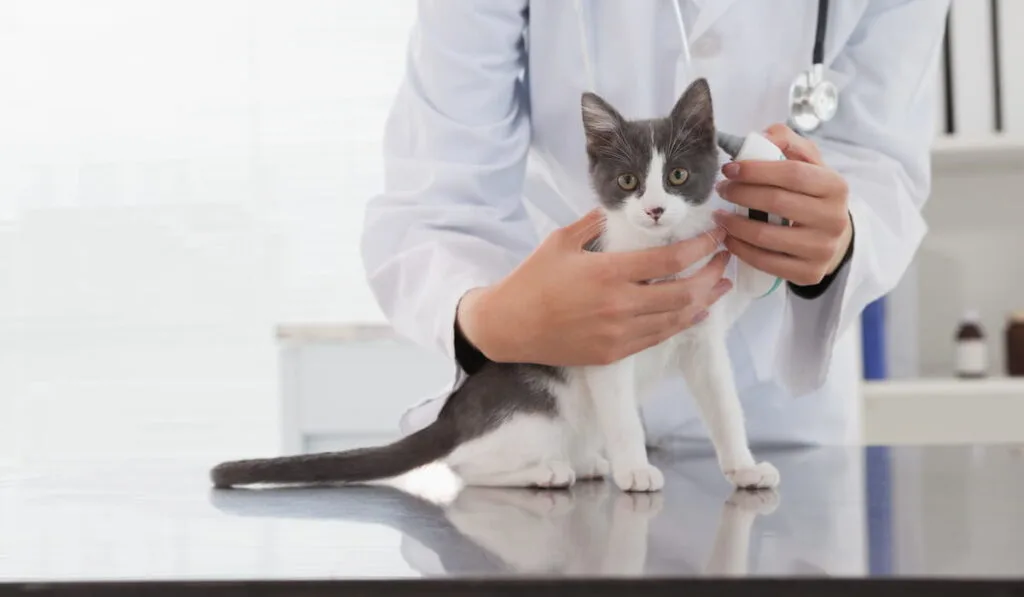
Veterinary Care for Kittens
Kittens should be taken to the veterinarian soon after being brought home, and it is important that you set your kitten up for their scheduled vaccinations.
All housecats require a rabies vaccination by law, but it’s also smart to inoculate your new kitten against other common cat-borne illnesses such as feline distemper and feline leukemia. In many cases, these shots are packaged together.
While these other vaccinations aren’t typically required by law, in many cases you won’t be allowed to board your cat with a vet or kennel unless they are fully vaccinated.
Leaving your cat unvaccinated can also lead to hundreds of dollars in unnecessary vet bills should your cat contract a preventable illness.
After your kitten has received its initial schedule of kitten vaccinations, it will usually require a rabies booster once every few years to maintain legal status. If you do not voluntarily take your cat in for its rabies booster, you will receive a notification reminding you to do it in the mail.
Past vaccinations, kittens should be given a physical exam at least twice in the first year of development to ensure that there aren’t any developing congenital conditions or problems that might negatively impact the kitten’s overall health.

Kittenhood to Adolescence
From the age of six months to a year, a kitten is considered an adolescent cat. At this point, it may become more energetic, playful, and (if not redirected into more positive activities) rambunctious.
Adolescence is the point in a cat’s life where it is very important to make sure that they receive plenty of stimulation to prevent the development of unwanted behaviors out of boredom.
Playing with your cat a lot during this age can also help strengthen the bond between you and the cat, and this play is a part of its natural development. Without it, cats can redirect their energy into aggression or damaging property for the fun of it.
There are a variety of toys that can help cats redirect their predatory instincts and help tire them out so they’re calmer around people.
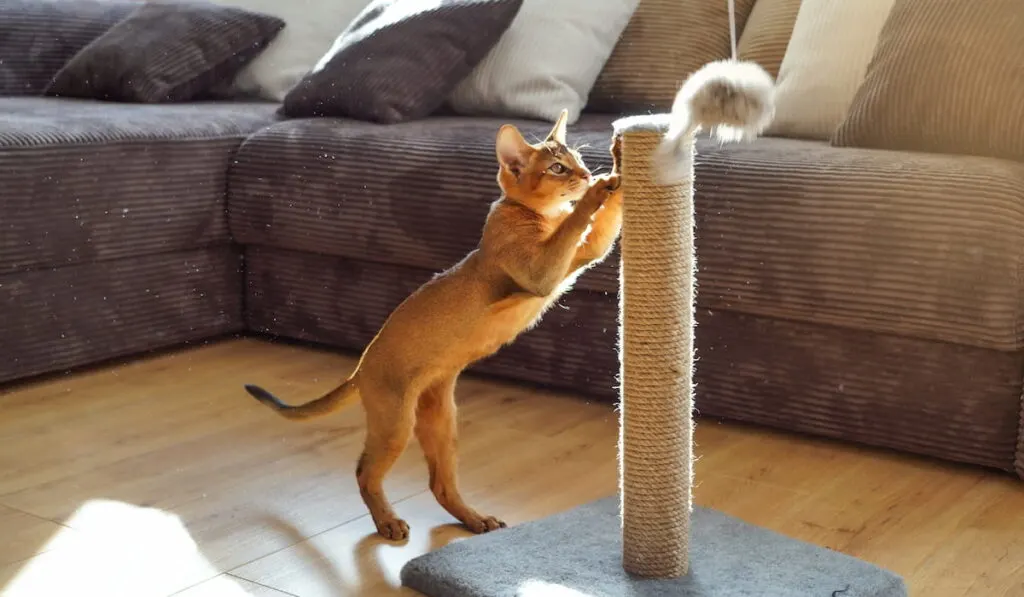
Without regular human contact, kittens can grow up into much more aloof or unfriendly cats, whereas cats that are well-socialized up through adolescence are much more sociable towards humans when they reach adulthood.
Veterinary Care for Adolescent Cats
It is crucial when you get a kitten that you plan ahead for the cat to be spayed or neutered. Female cats who aren’t spayed are capable of producing up to five litters of kittens a year.
This fertility is one of the reasons why there is such a large population of stray and feral cats across the world. Spaying and neutering help cut down on this deadly overpopulation.
Not only do unwanted litters of kittens lead to many more healthy animals euthanized each year than is necessary, but colonies of stray feral cats left to roam free are also devastating to local wildlife, such as songbird and small mammal populations.

There are low-income options for spaying or neutering your cat, so if the price is a concern check with your vet to see what kind of options are available to you. Ultimately if you can’t afford proper veterinary care for your kitten, you can’t afford to own a kitten.
Other than preventing unwanted pregnancies, it’s also important for you to spay or neuter your cat to avoid behavioral issues. When un-spayed female cats go into heat, they develop very annoying behaviors such as yowling and trying to escape the house.
When unneutered male cats come into their adolescence, they may begin spraying urine in the house to mark their territory or fight other toms.
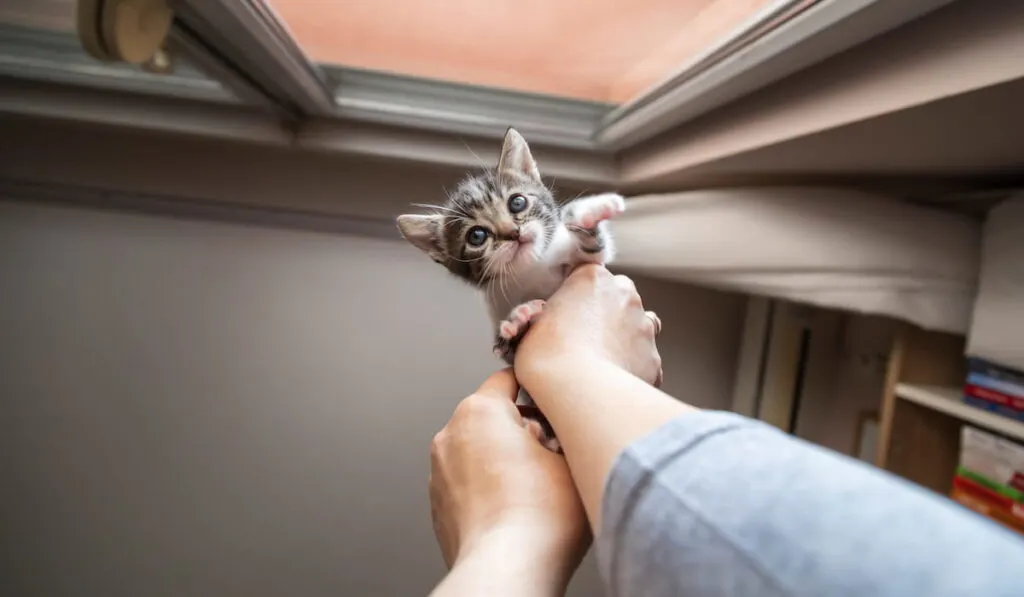
Spend Time with Your New Kitten to End Up with a Happy Cat
It’s important to provide the right veterinary care, accessories, and food for your new kitten, but ultimately the most important part of raising a kitten into a friendly cat is the socialization and bonding time you spend with it when it is young.
The more a cat is held, pet, and played with as a kitten and an adolescent cat, the more likely it will continue to display positive behavior as an adult.
Bringing home a cat for the first time can be daunting, but if you take the time to learn about how cats act and make sure your kitten has everything it needs before you pick it up, you’ll have a much easier time learning to enjoy your new feline friend.
